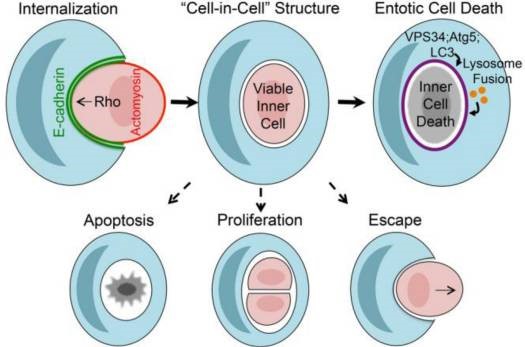Entotic cell death is a form of programmed cell "cannibalism", which refers to one cell engulfing and killing another cell. Creative Bioarray can provide accurate and convenient entotic cell death assays to help your research.
Entosis is a mechanism of cell competition occurring in cancers that involves the engulfment and killing of neighboring cells. The death of ingested cells, called entotic cell death, usually occurs in a non-apoptotic, autophagy protein-dependent manner, where microtubule-associated protein light chain 3 (LC3) is lipidated onto entotic vacuoles.
 Figure1. Mechanisms of entosis and entotic cell death. (Shefali Krishna, etal.2006)
Figure1. Mechanisms of entosis and entotic cell death. (Shefali Krishna, etal.2006)
Multiple mechanisms have emerged where the engulfment of whole live cells, leading to the formation of cell-in-cell structures, induces cell death. Entosis is one such mechanism that drives cell-in-cell formation during carcinogenesis and development. Our services include but are not limited to:
To distinguish between apoptotic and entotic cell death, Creative Bioarray can analyze movies for changes in cell and nuclear morphology in the DIC and fluorescent channels, respectively.
Monitoring acidification of the vacuoles that contain internalized cells can be used as a marker for entotic cell death. Acidification can be monitored by adding LysoTracker fluorescent dyes to the medium during time-lapse analysis; acidification of the entotic vacuole results in an increased and diffuse LysoTracker staining within internalized cells. Similarly, time-lapse imaging of fluorescently tagged lysosomal proteins expressed in host cells can be used as an indicator of lysosome fusion to the entotic vacuole, which is known to cause cell death.
Experiment Process

The time depends on the experiment content
If you are interested in our services, please contact us for more detailed information.
Reference:
Online Inquiry